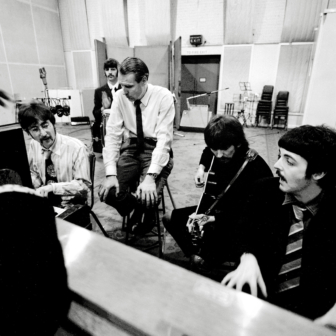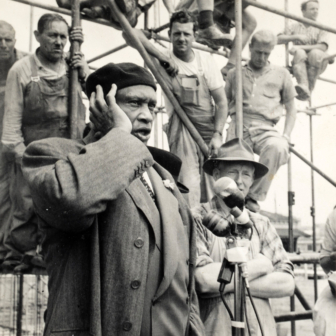EARLIER this year, an amazing thing happened in Melbourne. Fifteen thousand people gathered in front of the Victorian parliament to protest against an unpopular government decision. The colourful crowd chanted and marched, sported placards and banners, and listened to speeches by local identities.
What were they protesting about? Climate change? Refugees? The war in Afghanistan?
No, they were protesting about a decision by Liquor Licensing Victoria to enforce onerous security requirements on live music venues in Melbourne. The new regulations had led to the closure of one of Melbourne’s best-loved rock venues, a Collingwood pub named The Tote. Many other venues were threatened with the same fate. This was a protest about cultural policy.
“Cultural policy” is not often treated as an important public affairs issue. That’s odd when you consider that culture touches on many of the things that Australians do, see, hear and engage with everyday. Watching television, reading a newspaper, playing a computer game, updating your Facebook status, sending a tweet, going to a bar to see comedy, even things like gardening and cooking: all of these activities are explicitly cultural.
It’s unlikely this federal election will be won or lost on cultural policy. So far, the issue has been almost invisible in this year’s campaign, despite a ripple of attention attracted by the release of the Greens’ arts policy in Melbourne this week.
But the protests inspired by the closure of The Tote and the bureaucratic ineptitude that preceded it are a reminder that it has a constituency. Culture and the arts account for a bigger workforce in this country than mining and automobile manufacturing combined: 285,000 Australians work in a cultural occupation as their main job. The Australian Bureau of Statistics tells us that there are more than 77,000 registered cultural businesses, contributing a total cultural output approaching $41 billion. In 2003–04, Australian households spent $14.6 billion on cultural items like books, CDs and pay TV.
Culture is also a big part of our daily lives: watching television is Australians’ most important leisure activity, and the movies are our most popular destination when we go out. More than three-quarters of Australians read for pleasure, while nearly fourteen million of us attend a cultural venue or event at least once a year. More importantly, the impact of culture is beyond economics. It’s at the heart of our identity and way of life.
But all too often, when we discuss government policies towards “culture,” what we actually mean is “the arts” – and only a small subset of the arts at that. Indeed, when we think about cultural policy in Australia, we often think simply of grants to artists, or government cultural agencies such as the Australia Council, as though these are the principal aspects of government policy about culture.
In case we’ve forgotten just how reactionary and regressive the debate about the arts can be in this country, composer and opera director Richard Mills has helpfully reminded us, in an essay this week in the Age.
Sounding like a critic trampled in the riot on the first night of Stravinsky’s Rite of Spring, Mills thunders on about the new media arts in a tone that would be shocking if it were not so risible:
I was a member of the Australia Council for the Arts in the 1990s when the New Media Fund was set up. I opposed it vehemently – and in vain – as it seemed to me just another example of meretricious, self-serving claptrap, which confused content with process, masquerading to the weak-minded as new, with a healthy sense of entitlement to whatever funds might happen to drop from the perch of government.
Later in the piece, Mills describes being shown a piece of new media art.
I was ushered in and shown, in an atmosphere of hushed reverence, some examples of “new media” which, so far as I could tell, consisted of pictures of yellow flowers changing and moving about a bit on a TV screen.
“Humbug,” I exclaimed, “this belongs to the visual arts” – only to be howled down by the entire clutch of councillors of the day (except, if my memory serves me correctly, Christopher Pearson).
Thankfully, this nonsense, and other things like it, were recognised in their true colours some years later when my esteemed colleague Jonathan Mills (no relation) encouraged the abolition of the New Media Fund with enthusiasm – and final success.
Like the best satire, Mills’s essay skates close to the ridiculous. (When was the last time someone cried “humbug” in a policy discussion?) As spoof, Mills’s essay is a near-masterpiece. As sincere argument, it’s a train wreck. Mills gloats over the destruction of the Australia Council’s New Media Arts Board in 2004, as though it were some victory in the culture wars. He advances factually wrong statements – for instance, that grassroots music depends on musicians trained by symphony orchestras for the supply of expert teachers. He makes frankly embarrassing comments about jewellery and computer programming. More generally, in his rage against the dying of a light, he reveals himself to be as reactionary and ill-informed about other artforms as he is proficient in his own.
Mills’s essay is destined to become an important source document for those studying the current shape of Australian cultural policy. Sadly, one of Australia’s finest living composers has shown himself to possess a narrow critical mind. But Mills has also done us a favour, because he has been honest enough to reveal a widespread attitude among influential decision-makers in the Australian arts: the attitude that some forms of art, particularly their own, are more meritorious than others.
You don’t have to be a radical postmodernist or committed cultural relativist to desire a broader ambit for cultural policy – one broad enough to encompass crafts like jewellery or emerging artforms in the digital realm. Many classical musicians themselves would admit that the repertoire of our major orchestras and opera companies has become cramped and scholastic.
In truth, the debate about heritage artforms is a distraction from the broader policy debate. A key problem is that the current framework views cultural policy almost exclusively in terms of arts funding, rather than the much bigger area of cultural regulation. Things such as copyright laws, media regulation and censorship, urban planning and public liability laws, which affect the viability and diversity of cultural expression are beyond the reach of the current paradigm. Though they have a far greater impact on cultural life than the funding of any individual company or initiative, they are beyond the scope and responsibility of our cultural agencies.
When you look at Australian culture in all its richness, the inconsistency of policy responses reveals the ad hoc nature of the current approach.
For instance, Australian taxpayers spend hundreds of millions a year supporting Australian films, but not Australian computer games. We enforce some of the most stringent and punitive copyright laws in the world, without examining the costs of these special industry protections to consumers, schools, libraries and the public sphere. State governments promote contemporary music policies (“Victoria Rocks”) at the same time as imposing crippling regulations on the live venues that support that contemporary music (such as the laws that shut down The Tote). We create powerful economic incentives to replace live venues with poker machines without any evaluation of cultural consequences. We create building codes, zoning regulations and planning rules without regard to the capital constrained nature of cultural practice. We maintain inconsistent and incoherent approaches to media regulation that means adults can watch an R-rated movie, but not experience similar material in video games, and soon, perhaps, not on the internet either.
Another consequence of these inconsistencies is a sustained lack of funding and support for Australia’s Indigenous cultural expressions. In cultural funding terms, the “great Australian silence” towards the richness and diversity of Aboriginal and Torres Strait Islander cultures, first named and described by anthropologist W.E.H. Stanner in 1968, still continues today. While some of the oldest living forms of music in the world slowly die out in central Australia, the Australia Council gives more than five times more money to Opera Australia than it does to its entire Aboriginal and Torres Strait Islander Arts Board.
BUT OUR cultural policy debate rarely discusses these issues. As a result, many parts of the sector languish. Ordinary working artists, for instance, continue to get by on the smell of an oily rag; the last rigorous study of artists incomes, David Throsby and Virginia Hollister’s 2003 report Don’t Give Up Your Day Job, found that the mean creative income for an independent artist working in Australia was only $17,000 per annum (in a year when the average annual wage in Australia was about $52,300). But in that year, the Australia Council distributed just 6.3 per cent of its grant funding to independent artists. Ninety-three per cent went to organisations. A recent, comprehensive survey of Australian arts funding commissioned by Arts Queensland found that “grants to individual artists to make work are estimated to be fewer than 5 per cent of all arts funding.”
The result of current policy settings has been the neglect of many to the benefit of a privileged few – not because their artforms are more marvellous, but because their champions have lobbied harder and enjoyed a dominant position in the cultural debate. This has meant that, for instance, the rapid encroachment of Australian copyright laws into the public domain has generally been defended with reference to the rights of artists and composers, without reference to the benefits to industry or the competing rights of copyright users like schools, libraries and other artists.
Similarly, calls to reform the Australia Council are generally met with defensive outrage over the perceived threat to what Mills calls “the currency of the extraordinary.” But the Australia Council desperately needs reform: its structure and artistic focus has changed little since the 1970s, while culture has changed all around it, driven by new technologies such as the internet. More importantly, its supposedly important functions of peer review, advocacy and arm’s-length policy analysis have withered away to almost nothing. In monetary terms, the majority of the grant dollars it distributes are not peer-reviewed at all. This is one reason why only 2 per cent of the approximately $90 million the Australia Council devotes to music funding goes to jazz, rock, pop and other contemporary forms of music.
It’s worth re-examining the Australia Council’s pivotal decision of the 2000s, to abolish the New Media Arts Board. The result of this decision was not just a symbolic reorganisation. It also locked in the Australia Council’s reluctance to engage meaningfully with digital and new media arts, social networking, or gaming. Yet these are some of the largest and fastest-growing areas of culture today. We desperately need a planning and development agency whose primary concern is contemporary cultural dynamics, opportunities and developments, and not merely heritage preservation.
This is why the cultural policy debate must move past the issue of arts funding. One possible way forward is to reframe the debate around ideas of innovation and participation across the board, rather than a series of policies that single out specific artforms or cultural expressions. In media policy, this might mean policies that expand the choices and options for media consumers, rather than the industry protections of media proprietors. In copyright, it might mean developing a new copyright framework that balances the rights of copyright holders (generally big media companies) with copyright users (generally consumers and public institutions like schools and libraries). In arts policy, it could signal a move away from heritage artforms and traditions, and towards support for living artists who are making new work.
Whatever the result, one outcome we can hope for is a robust debate. In a forthcoming series of essays and articles, Marcus Westbury and I are trying to start one up. It is high time we had this debate. It might even lead to much-needed reform. •




